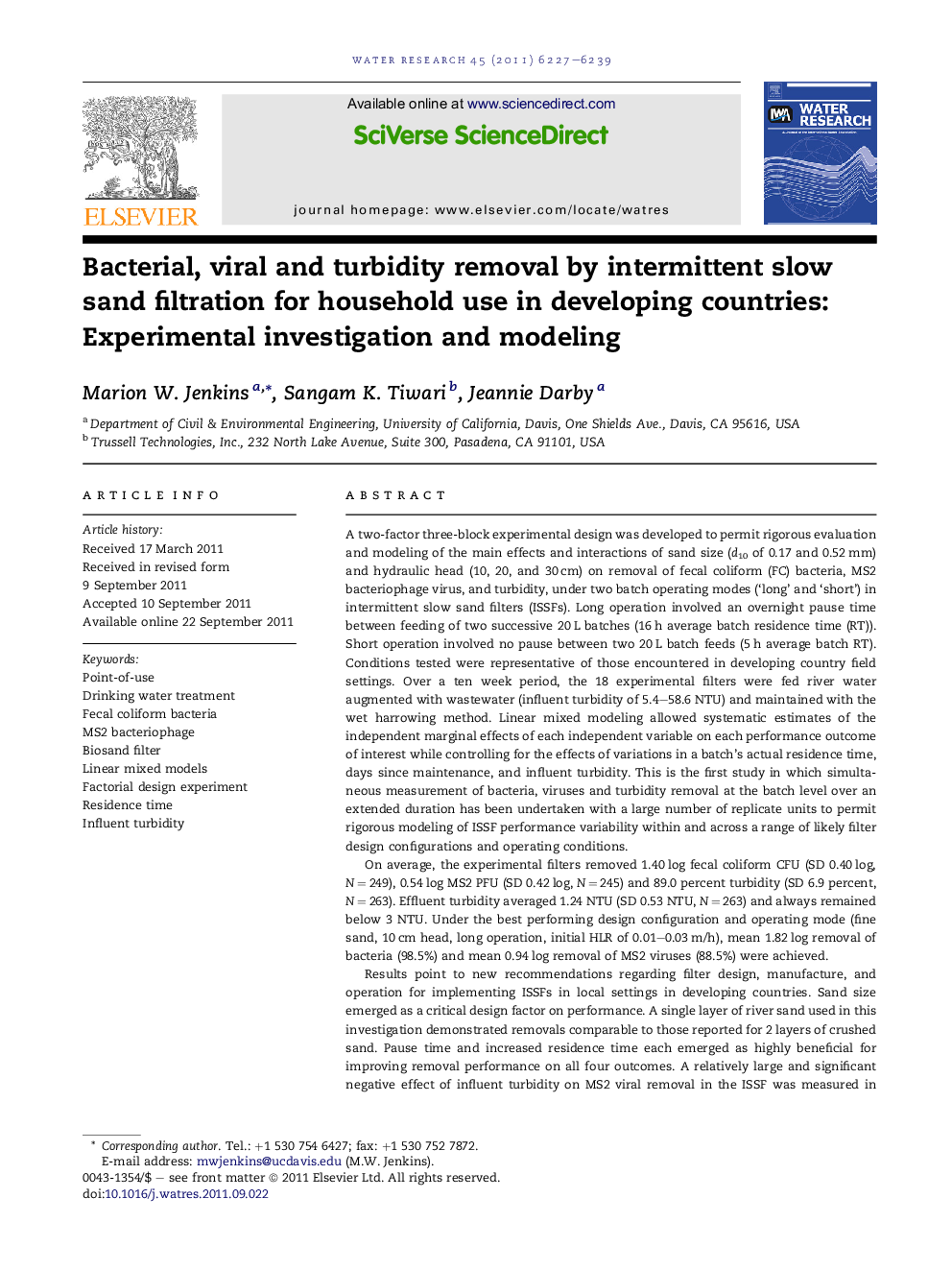| کد مقاله | کد نشریه | سال انتشار | مقاله انگلیسی | نسخه تمام متن |
|---|---|---|---|---|
| 4482706 | 1316866 | 2011 | 13 صفحه PDF | دانلود رایگان |

A two-factor three-block experimental design was developed to permit rigorous evaluation and modeling of the main effects and interactions of sand size (d10 of 0.17 and 0.52 mm) and hydraulic head (10, 20, and 30 cm) on removal of fecal coliform (FC) bacteria, MS2 bacteriophage virus, and turbidity, under two batch operating modes (‘long’ and ‘short’) in intermittent slow sand filters (ISSFs). Long operation involved an overnight pause time between feeding of two successive 20 L batches (16 h average batch residence time (RT)). Short operation involved no pause between two 20 L batch feeds (5 h average batch RT). Conditions tested were representative of those encountered in developing country field settings. Over a ten week period, the 18 experimental filters were fed river water augmented with wastewater (influent turbidity of 5.4–58.6 NTU) and maintained with the wet harrowing method. Linear mixed modeling allowed systematic estimates of the independent marginal effects of each independent variable on each performance outcome of interest while controlling for the effects of variations in a batch’s actual residence time, days since maintenance, and influent turbidity. This is the first study in which simultaneous measurement of bacteria, viruses and turbidity removal at the batch level over an extended duration has been undertaken with a large number of replicate units to permit rigorous modeling of ISSF performance variability within and across a range of likely filter design configurations and operating conditions.On average, the experimental filters removed 1.40 log fecal coliform CFU (SD 0.40 log, N = 249), 0.54 log MS2 PFU (SD 0.42 log, N = 245) and 89.0 percent turbidity (SD 6.9 percent, N = 263). Effluent turbidity averaged 1.24 NTU (SD 0.53 NTU, N = 263) and always remained below 3 NTU. Under the best performing design configuration and operating mode (fine sand, 10 cm head, long operation, initial HLR of 0.01–0.03 m/h), mean 1.82 log removal of bacteria (98.5%) and mean 0.94 log removal of MS2 viruses (88.5%) were achieved.Results point to new recommendations regarding filter design, manufacture, and operation for implementing ISSFs in local settings in developing countries. Sand size emerged as a critical design factor on performance. A single layer of river sand used in this investigation demonstrated removals comparable to those reported for 2 layers of crushed sand. Pause time and increased residence time each emerged as highly beneficial for improving removal performance on all four outcomes. A relatively large and significant negative effect of influent turbidity on MS2 viral removal in the ISSF was measured in parallel with a much smaller weaker positive effect of influent turbidity on FC bacterial removal. Disturbance of the schmutzdecke by wet harrowing showed no effect on virus removal and a modest reductive effect on the bacterial and turbidity removal as measured 7 days or more after the disturbance. For existing coarse sand ISSFs, this research indicates that a reduction in batch feed volume, effectively reducing the operating head and increasing the pore:batch volume ratio, could improve their removal performance by increasing batch residence time.
► 2-factor 3-block experiment on sand size, head, and operation effects, interactions.
► Removal of bacteria, virus and turbidity, and measurement of effluent turbidity.
► 18 filters operated 10 weeks with conditions representative of developing country.
► All outcomes improved by fine sand, long residence time (pause) operation.
► Negative effect of influent turbidity on viral removal.
Journal: Water Research - Volume 45, Issue 18, 15 November 2011, Pages 6227–6239